Abstract
Reassortant viruses which possessed the hemagglutinin and neuraminidase genes of wild-type human influenza A viruses and the remaining six RNA segments (internal genes) of the avian A/Pintail/Alberta/119/79 (H4N6) virus were previously found to be attenuated in humans. To study the genetic basis of this attenuation, we isolated influenza A/Pintail/79 X A/Washington/897/80 reassortant viruses which contained human influenza virus H3N2 surface glycoprotein genes and various combinations of avian or human influenza virus internal genes. Twenty-four reassortant viruses were isolated and first evaluated for infectivity in avian (primary chick kidney [PCK]) and mammalian (Madin-Darby canine kidney [MDCK]) tissue culture lines. Reassortant viruses with two specific constellations of viral polymerase genes exhibited a significant host range restriction of replication in mammalian (MDCK) tissue culture compared with that in avian (PCK) tissue culture. The viral polymerase genotype PB2-avian (A) virus, PB1-A virus, and PA-human (H) virus was associated with a 900-fold restriction, while the viral polymerase genotype PB2-H, PB1-A, and PA-H was associated with an 80,000-fold restriction of replication in MDCK compared with that in PCK. Fifteen reassortant viruses were subsequently evaluated for their level of replication in the respiratory tract of squirrel monkeys, and two genetic determinants of attenuation were identified. First, reassortant viruses which possessed the avian influenza virus nucleoprotein gene were as restricted in replication as a virus which possessed all six internal genes of the avian influenza A virus parent, indicating that the nucleoprotein gene is the major determinant of attenuation of avian-human A/Pintail/79 reassortant viruses for monkeys. Second, reassortant viruses which possessed the viral polymerase gene constellation of PB2-H, PB1-A, and PA-H, which was associated with the greater degree of host range restriction in vitro, were highly restricted in replication in monkeys. Since the avian-human influenza reassortant viruses which expressed either mode of attenuation in monkeys replicated to high titer in eggs and in PCK tissue culture, their failure to replicate efficiently in the respiratory epithelium of primates must be due to the failure of viral factors to interact with primate host cell factors. The implications of these findings for the development of live-virus vaccines and for the evolution of influenza A viruses in nature are discussed.
Full text
PDF
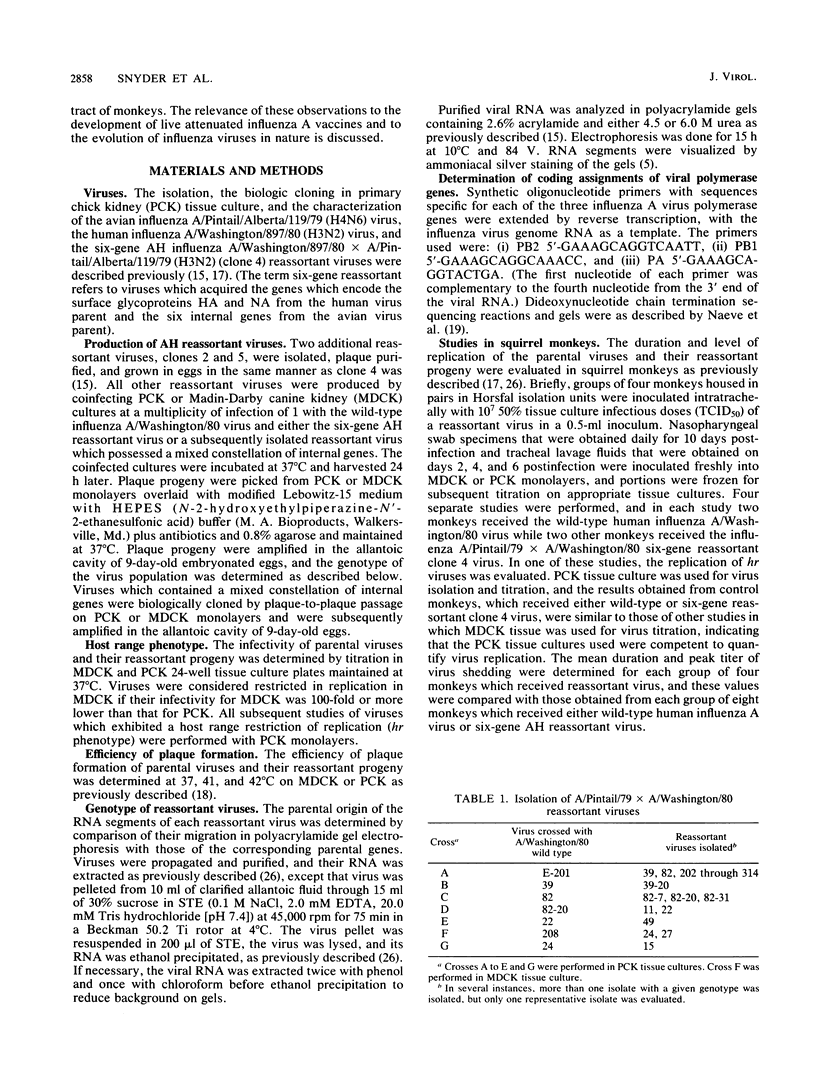
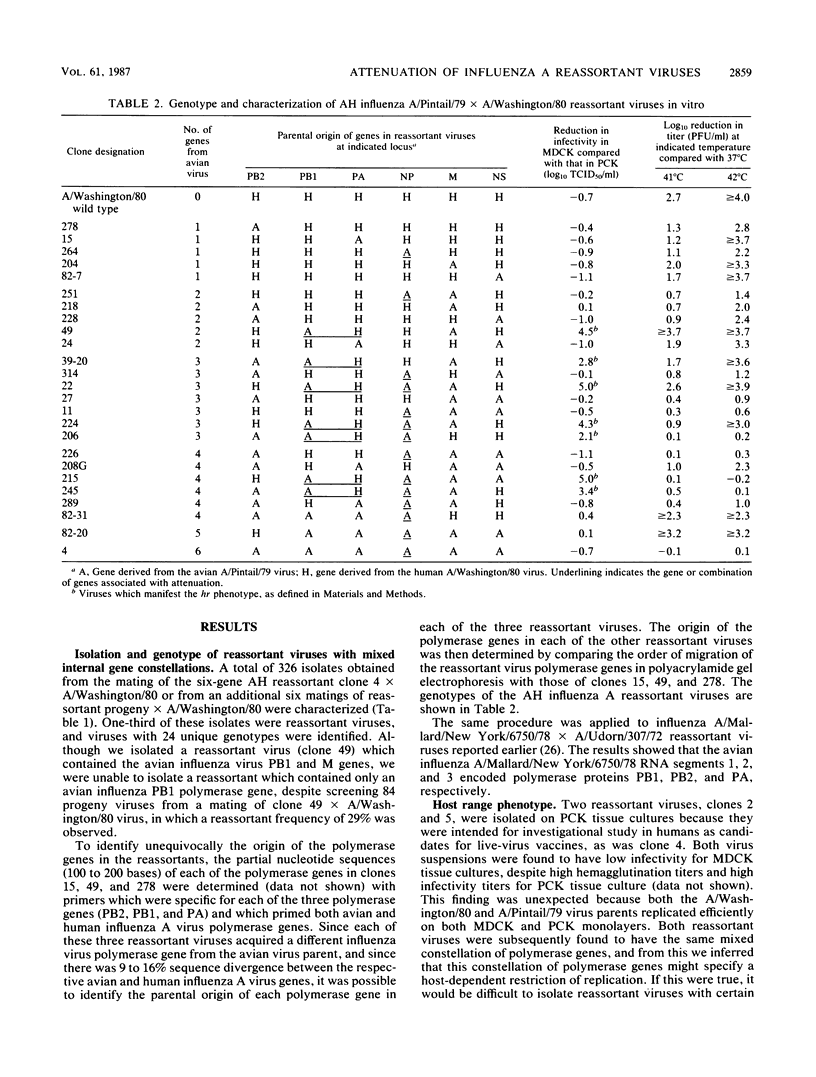
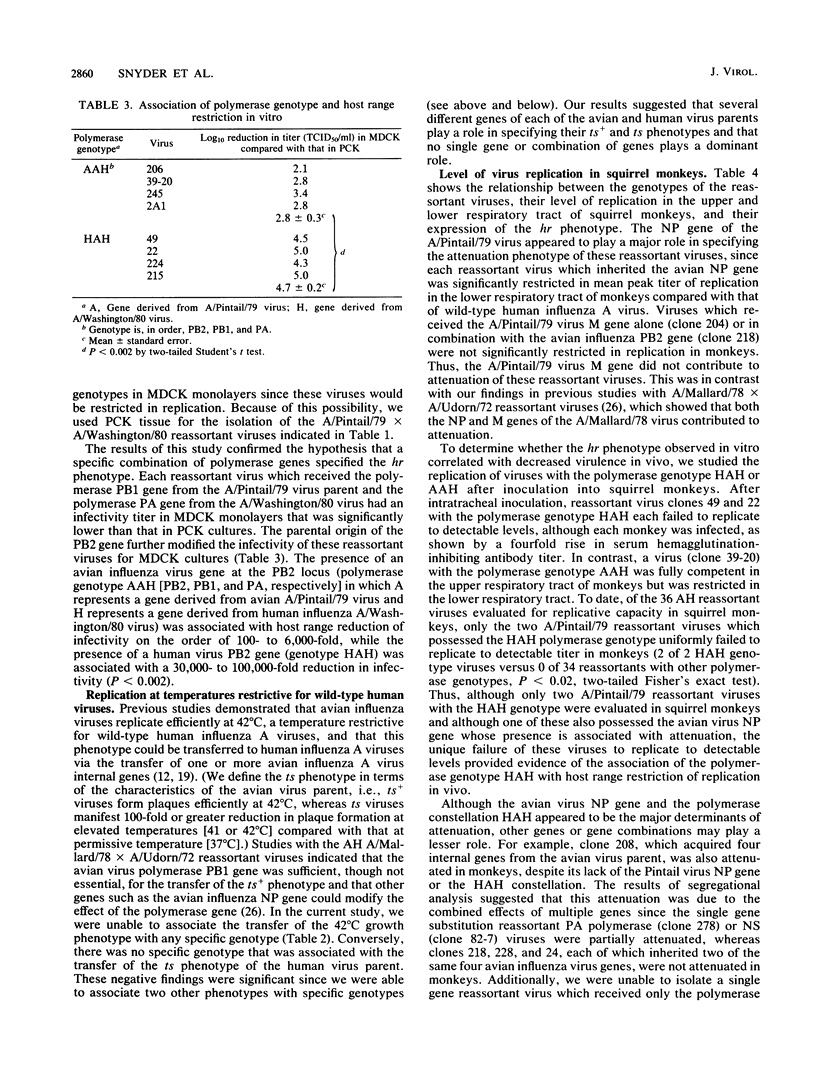
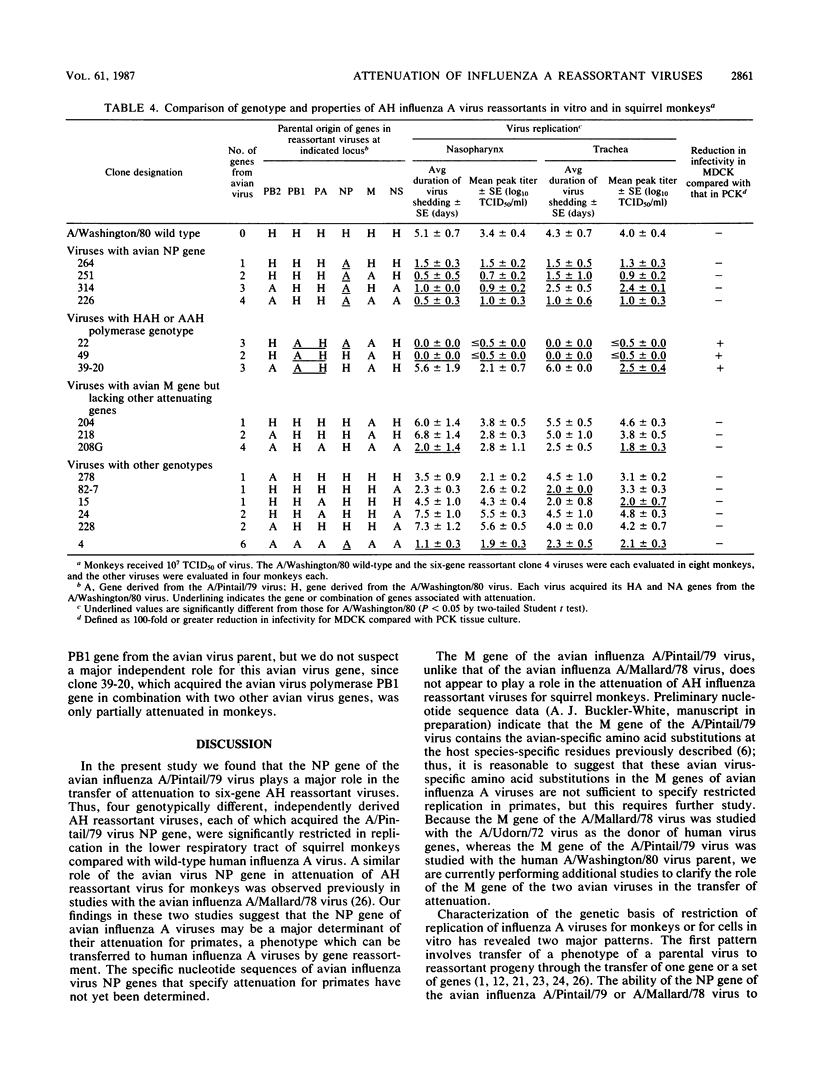
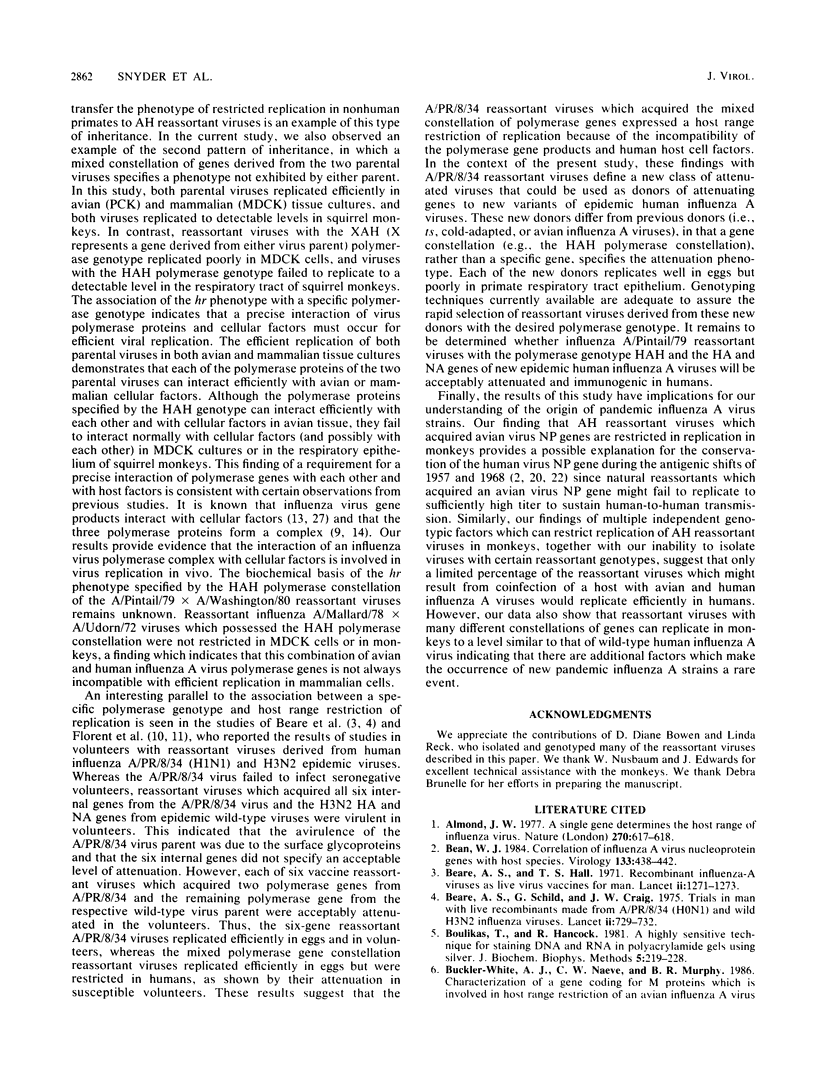
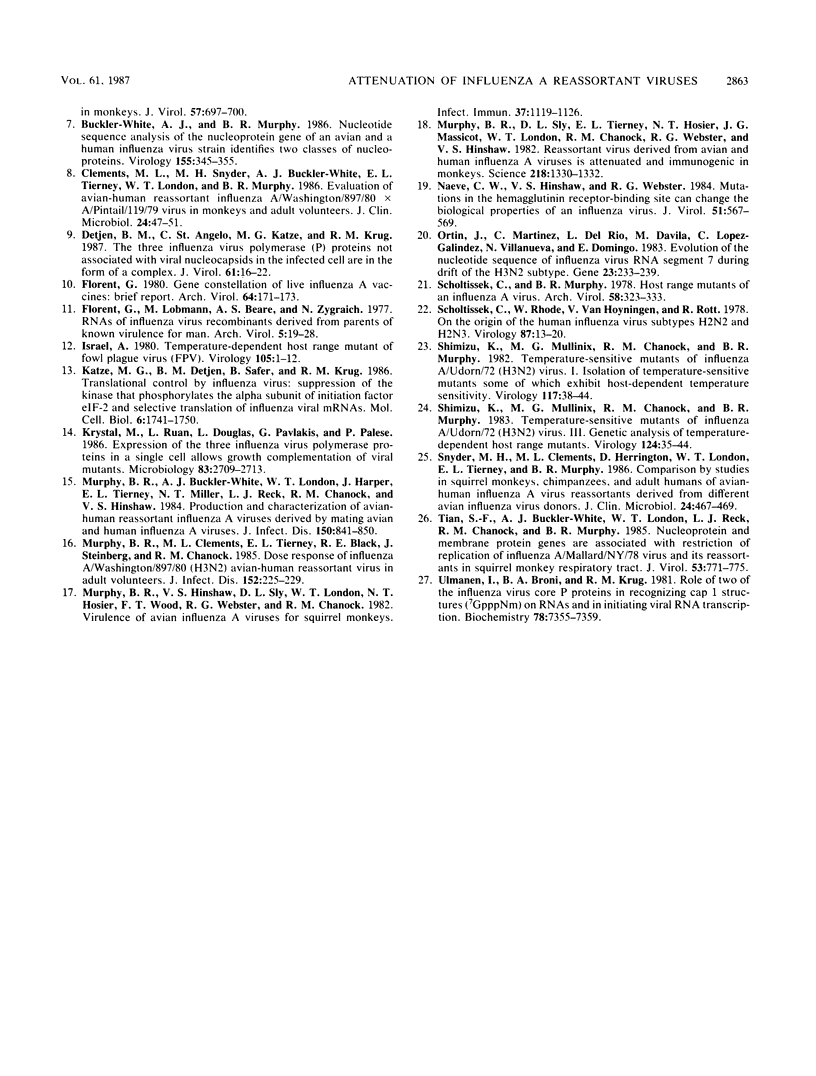
Selected References
These references are in PubMed. This may not be the complete list of references from this article.
- Almond J. W. A single gene determines the host range of influenza virus. Nature. 1977 Dec 15;270(5638):617–618. doi: 10.1038/270617a0. [DOI] [PubMed] [Google Scholar]
- Bean W. J. Correlation of influenza A virus nucleoprotein genes with host species. Virology. 1984 Mar;133(2):438–442. doi: 10.1016/0042-6822(84)90410-0. [DOI] [PubMed] [Google Scholar]
- Beare A. S., Hall T. S. Recombinant influenza-A viruses as live vaccines for man. Report to the Medical Research Council's Committee on Influenza and other Respiratory Virus Vaccines. Lancet. 1971 Dec 11;2(7737):1271–1273. doi: 10.1016/s0140-6736(71)90597-6. [DOI] [PubMed] [Google Scholar]
- Beare A. S., Schild G. C., Craig J. W. Trials in man with live recombinants made from A/PR/8/34 (H0 N1) and wild H3 N2 influenza viruses. Lancet. 1975 Oct 18;2(7938):729–732. doi: 10.1016/s0140-6736(75)90720-5. [DOI] [PubMed] [Google Scholar]
- Boulikas T., Hancock R. A highly sensitive technique for staining DNA and RNA in polyacrylamide gels using silver. J Biochem Biophys Methods. 1981 Oct;5(4):219–228. doi: 10.1016/0165-022x(81)90046-4. [DOI] [PubMed] [Google Scholar]
- Buckler-White A. J., Murphy B. R. Nucleotide sequence analysis of the nucleoprotein gene of an avian and a human influenza virus strain identifies two classes of nucleoproteins. Virology. 1986 Dec;155(2):345–355. doi: 10.1016/0042-6822(86)90198-4. [DOI] [PubMed] [Google Scholar]
- Buckler-White A. J., Naeve C. W., Murphy B. R. Characterization of a gene coding for M proteins which is involved in host range restriction of an avian influenza A virus in monkeys. J Virol. 1986 Feb;57(2):697–700. doi: 10.1128/jvi.57.2.697-700.1986. [DOI] [PMC free article] [PubMed] [Google Scholar]
- Clements M. L., Snyder M. H., Buckler-White A. J., Tierney E. L., London W. T., Murphy B. R. Evaluation of avian-human reassortant influenza A/Washington/897/80 x A/Pintail/119/79 virus in monkeys and adult volunteers. J Clin Microbiol. 1986 Jul;24(1):47–51. doi: 10.1128/jcm.24.1.47-51.1986. [DOI] [PMC free article] [PubMed] [Google Scholar]
- Detjen B. M., St Angelo C., Katze M. G., Krug R. M. The three influenza virus polymerase (P) proteins not associated with viral nucleocapsids in the infected cell are in the form of a complex. J Virol. 1987 Jan;61(1):16–22. doi: 10.1128/jvi.61.1.16-22.1987. [DOI] [PMC free article] [PubMed] [Google Scholar]
- Florent G. Gene constellation of live influenza A vaccines. Arch Virol. 1980;64(2):171–173. doi: 10.1007/BF01318021. [DOI] [PubMed] [Google Scholar]
- Florent G., Lobmann M., Beare A. S., Zygraich N. RNAs of influenza virus recombinants derived from parents of known virulence for man. Arch Virol. 1977;54(1-2):19–28. doi: 10.1007/BF01314375. [DOI] [PubMed] [Google Scholar]
- Israël A. A temperature-dependent host range mutant of fowl plague virus (FPV). Virology. 1980 Aug;105(1):1–12. doi: 10.1016/0042-6822(80)90150-6. [DOI] [PubMed] [Google Scholar]
- Katze M. G., Detjen B. M., Safer B., Krug R. M. Translational control by influenza virus: suppression of the kinase that phosphorylates the alpha subunit of initiation factor eIF-2 and selective translation of influenza viral mRNAs. Mol Cell Biol. 1986 May;6(5):1741–1750. doi: 10.1128/mcb.6.5.1741. [DOI] [PMC free article] [PubMed] [Google Scholar]
- Krystal M., Li R., Lyles D., Pavlakis G., Palese P. Expression of the three influenza virus polymerase proteins in a single cell allows growth complementation of viral mutants. Proc Natl Acad Sci U S A. 1986 Apr;83(8):2709–2713. doi: 10.1073/pnas.83.8.2709. [DOI] [PMC free article] [PubMed] [Google Scholar]
- Murphy B. R., Buckler-White A. J., London W. T., Harper J., Tierney E. L., Miller N. T., Reck L. J., Chanock R. M., Hinshaw V. S. Avian-human reassortant influenza A viruses derived by mating avian and human influenza A viruses. J Infect Dis. 1984 Dec;150(6):841–850. doi: 10.1093/infdis/150.6.841. [DOI] [PubMed] [Google Scholar]
- Murphy B. R., Clements M. L., Tierney E. L., Black R. E., Stienberg J., Chanock R. M. Dose response of influenza A/Washington/897/80 (H3N2) avian-human reassortant virus in adult volunteers. J Infect Dis. 1985 Jul;152(1):225–229. doi: 10.1093/infdis/152.1.225. [DOI] [PubMed] [Google Scholar]
- Murphy B. R., Hinshaw V. S., Sly D. L., London W. T., Hosier N. T., Wood F. T., Webster R. G., Chanock R. M. Virulence of avian influenza A viruses for squirrel monkeys. Infect Immun. 1982 Sep;37(3):1119–1126. doi: 10.1128/iai.37.3.1119-1126.1982. [DOI] [PMC free article] [PubMed] [Google Scholar]
- Murphy B. R., Sly D. L., Tierney E. L., Hosier N. T., Massicot J. G., London W. T., Chanock R. M., Webster R. G., Hinshaw V. S. Reassortant virus derived from avian and human influenza A viruses is attenuated and immunogenic in monkeys. Science. 1982 Dec 24;218(4579):1330–1332. doi: 10.1126/science.6183749. [DOI] [PubMed] [Google Scholar]
- Naeve C. W., Hinshaw V. S., Webster R. G. Mutations in the hemagglutinin receptor-binding site can change the biological properties of an influenza virus. J Virol. 1984 Aug;51(2):567–569. doi: 10.1128/jvi.51.2.567-569.1984. [DOI] [PMC free article] [PubMed] [Google Scholar]
- Ortín J., Martínez C., del Río L., Dávila M., López-Galíndez C., Villanueva N., Domingo E. Evolution of the nucleotide sequence of influenza virus RNA segment 7 during drift of the H3N2 subtype. Gene. 1983 Aug;23(2):233–239. doi: 10.1016/0378-1119(83)90055-0. [DOI] [PubMed] [Google Scholar]
- Scholtissek C., Murphy B. R. Host range mutants of an influenza A virus. Arch Virol. 1978;58(4):323–333. doi: 10.1007/BF01317824. [DOI] [PubMed] [Google Scholar]
- Scholtissek C., Rohde W., Von Hoyningen V., Rott R. On the origin of the human influenza virus subtypes H2N2 and H3N2. Virology. 1978 Jun 1;87(1):13–20. doi: 10.1016/0042-6822(78)90153-8. [DOI] [PubMed] [Google Scholar]
- Shimizu K., Mullinix M. G., Chanock R. M., Murphy B. R. Temperature-sensitive mutants of influenza A/Udorn/72 (H3N2) virus. I. Isolation of temperature-sensitive mutants some of which exhibit host-dependent temperature sensitivity. Virology. 1982 Feb;117(1):38–44. doi: 10.1016/0042-6822(82)90505-0. [DOI] [PubMed] [Google Scholar]
- Shimizu K., Mullinix M. G., Chanock R. M., Murphy B. R. Temperature-sensitive mutants of influenza A/Udorn/72 (H3N2) virus. III. Genetic analysis of temperature-dependent host range mutants. Virology. 1983 Jan 15;124(1):35–44. doi: 10.1016/0042-6822(83)90288-x. [DOI] [PubMed] [Google Scholar]
- Snyder M. H., Clements M. L., Herrington D., London W. T., Tierney E. L., Murphy B. R. Comparison by studies in squirrel monkeys, chimpanzees, and adult humans of avian-human influenza A virus reassortants derived from different avian influenza virus donors. J Clin Microbiol. 1986 Sep;24(3):467–469. doi: 10.1128/jcm.24.3.467-469.1986. [DOI] [PMC free article] [PubMed] [Google Scholar]
- Tian S. F., Buckler-White A. J., London W. T., Reck L. J., Chanock R. M., Murphy B. R. Nucleoprotein and membrane protein genes are associated with restriction of replication of influenza A/Mallard/NY/78 virus and its reassortants in squirrel monkey respiratory tract. J Virol. 1985 Mar;53(3):771–775. doi: 10.1128/jvi.53.3.771-775.1985. [DOI] [PMC free article] [PubMed] [Google Scholar]
- Ulmanen I., Broni B. A., Krug R. M. Role of two of the influenza virus core P proteins in recognizing cap 1 structures (m7GpppNm) on RNAs and in initiating viral RNA transcription. Proc Natl Acad Sci U S A. 1981 Dec;78(12):7355–7359. doi: 10.1073/pnas.78.12.7355. [DOI] [PMC free article] [PubMed] [Google Scholar]


